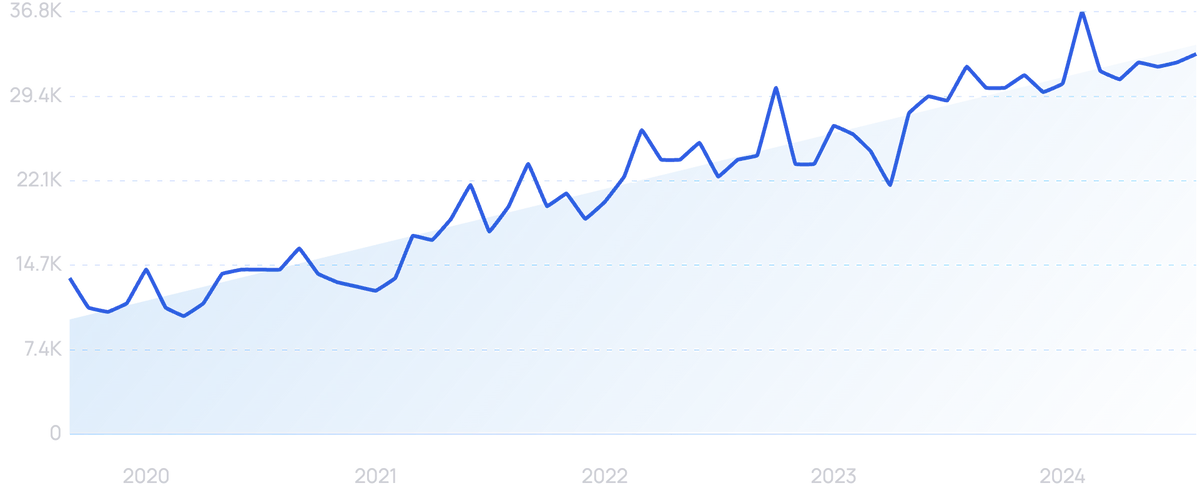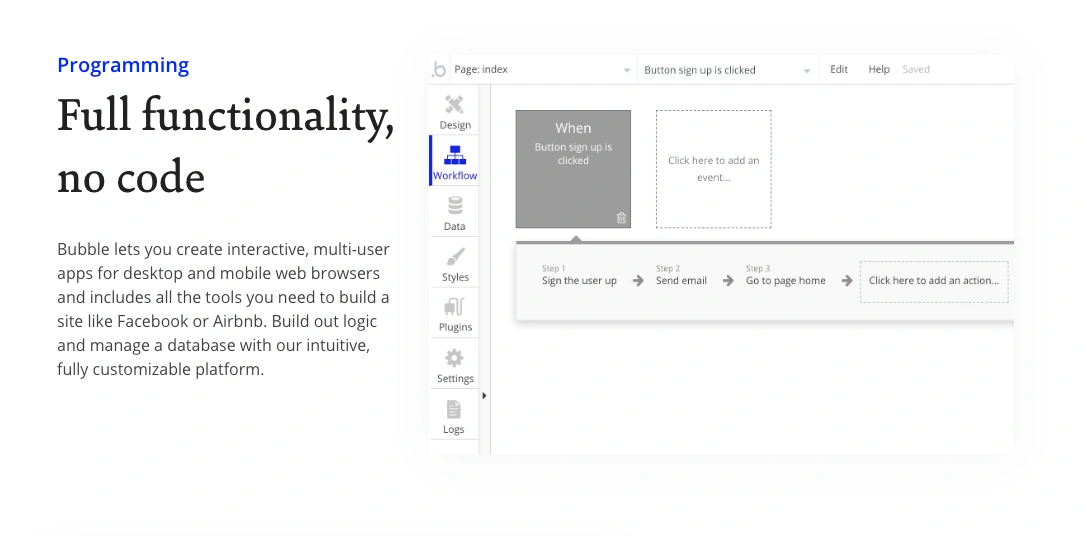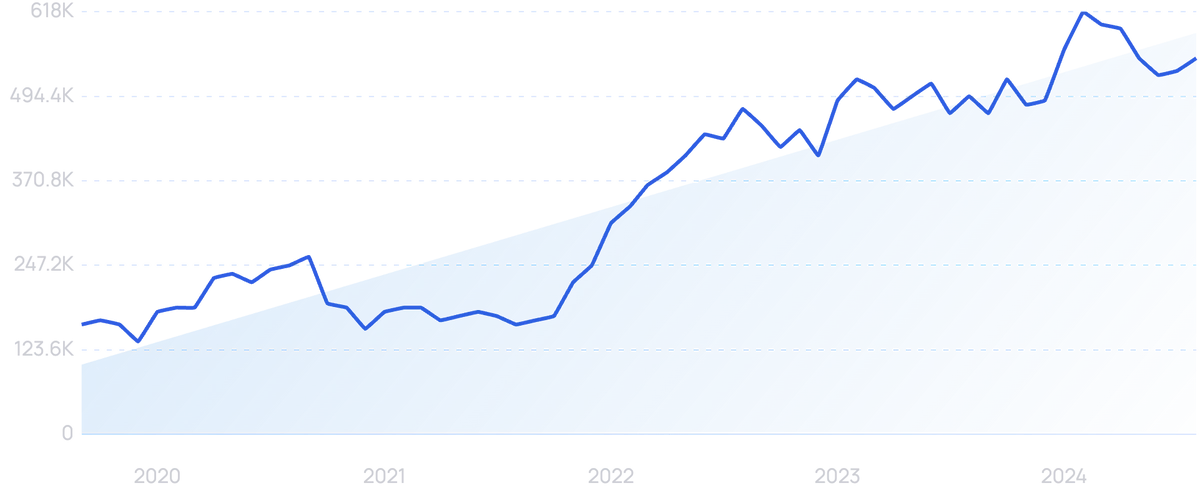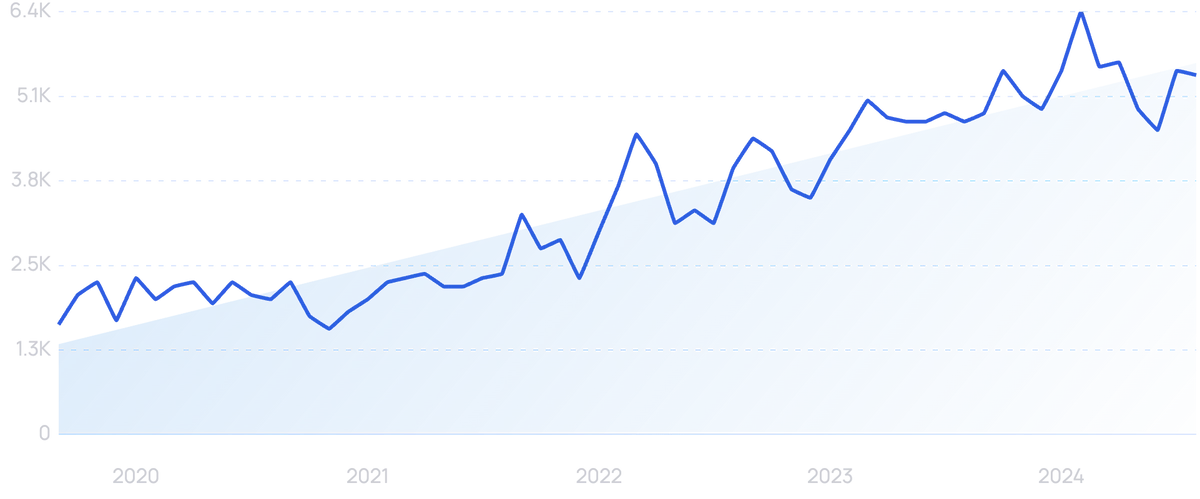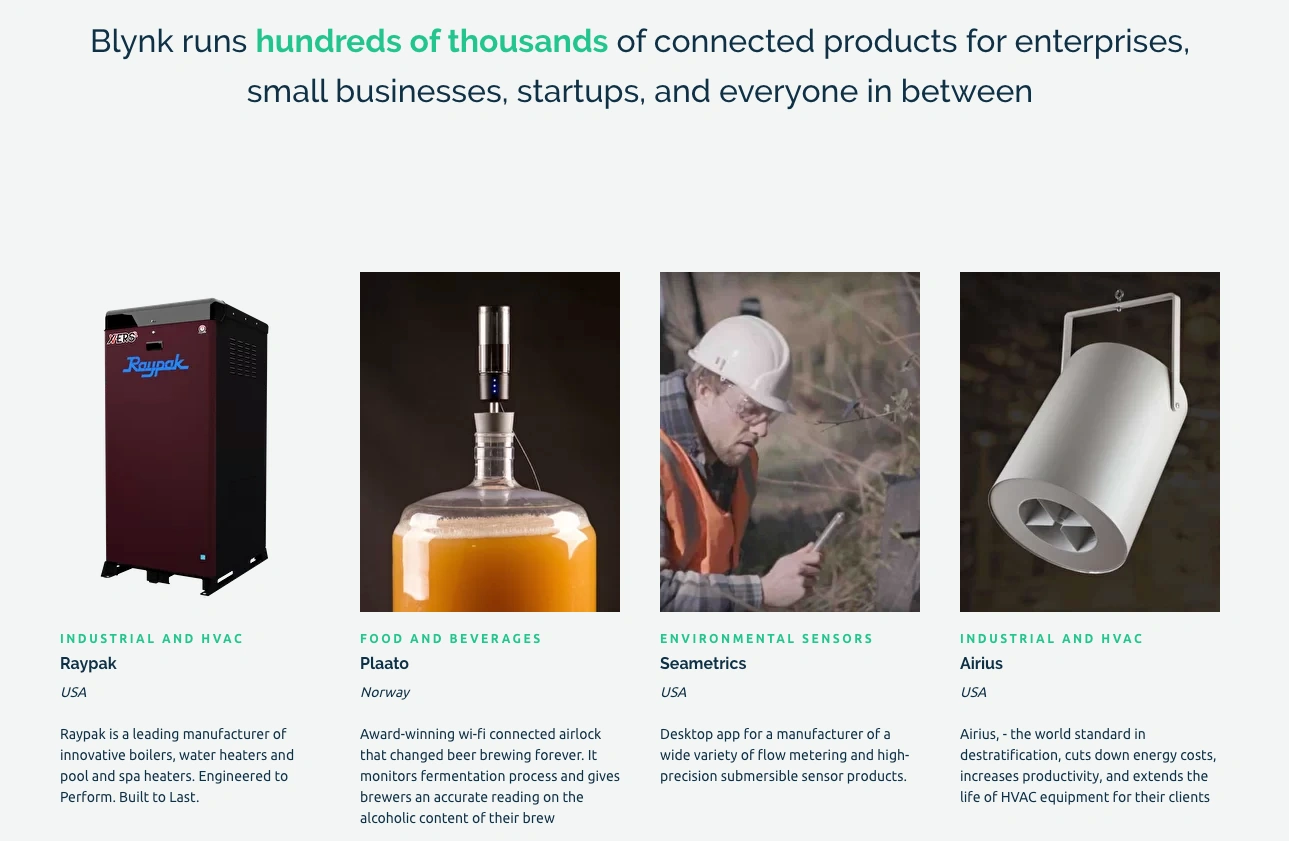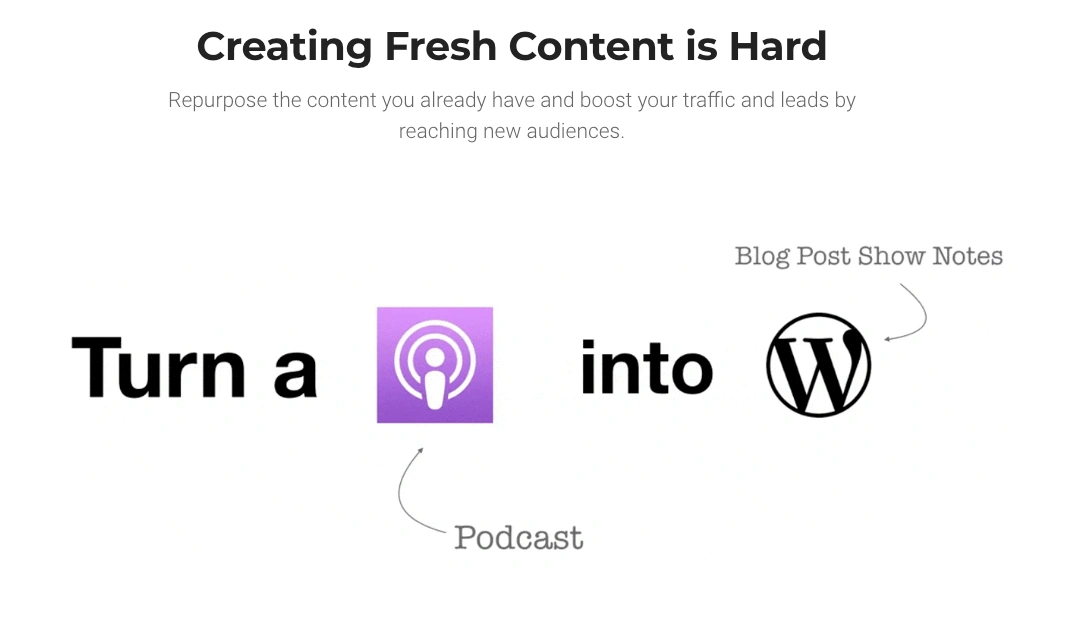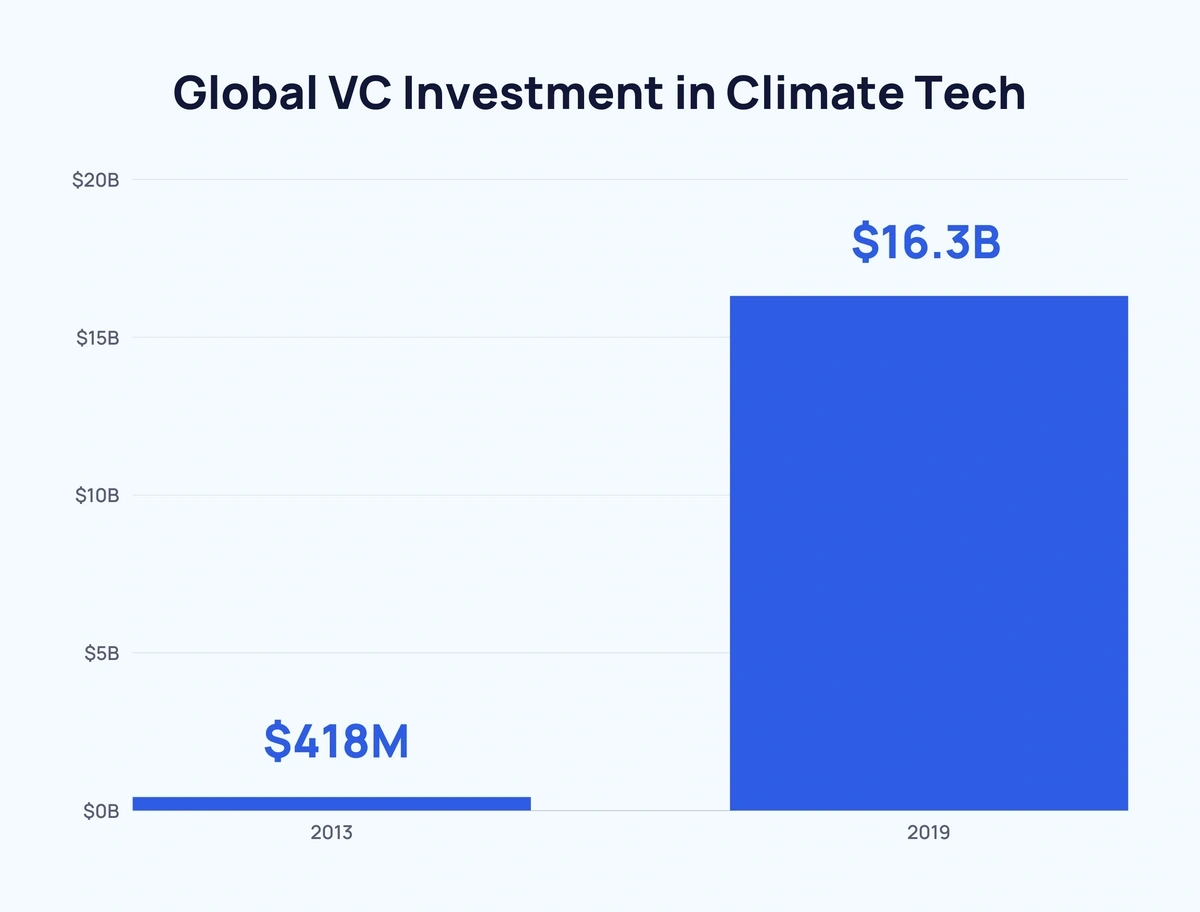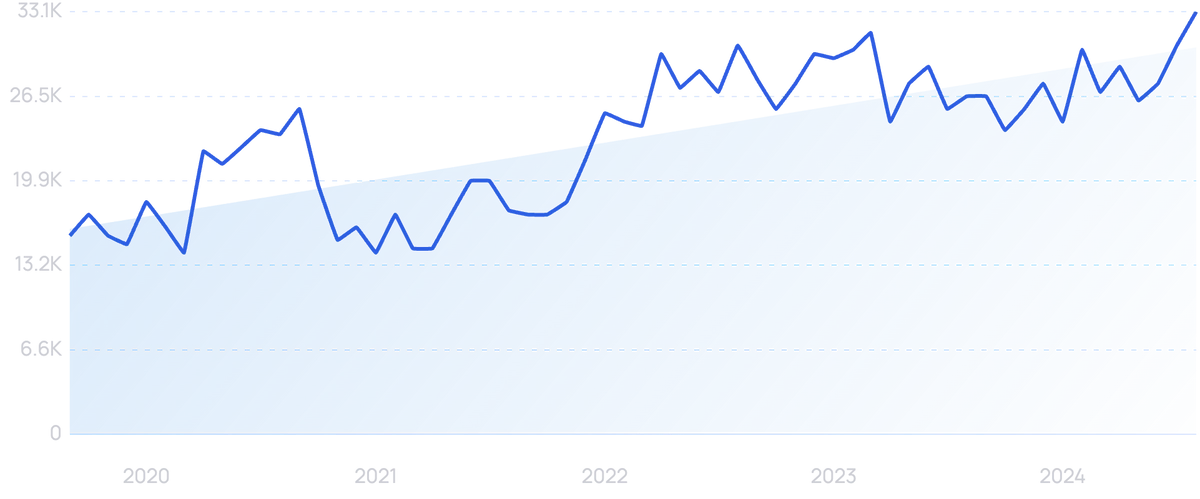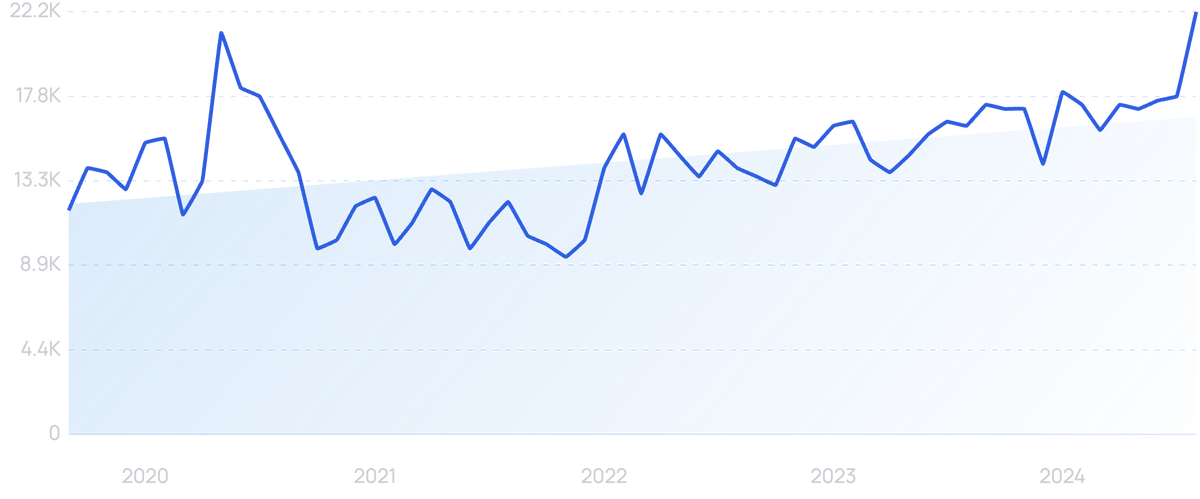
8 Top Entrepreneurship Trends (2024-2026)
You may also like:
Here are 8 important entrepreneurship trends happening right now.
Along with technology, business, and cultural changes are setting these trends.
Whether you're a seasoned entrepreneur or entirely new to the business world, these are the top entrepreneurship trends to watch.
1. Entrepreneurs Increasingly Rely On No-Code Platforms
“Low-code” searches have increased by 143% in 5 years.
No code (and its close cousin, low-code) refers to web and mobile development using a drag-and-drop interface.
Both approaches require much less technical knowledge than building via web programming languages and raw code.
Low code enables anyone to build and create blogs, online marketplaces, and even fully-fledged Software as a Service (SaaS) apps.
All without the need for a developer or designer.
Bubble is one of the top platforms for building no-code web apps quickly and easily.
As a result, entire industries are now accessible to “non-technical” entrepreneurs.
(This is part of the reason that Research and Markets estimates that the low-code industry could be worth $45.5 billion by 2025).
But even seasoned web developers often use no-code solutions (like Webflow) as a fast way to build apps quickly or prototype business ideas.
Google searches for "Webflow" have increased by 242% over the last 5 years.
And as this low-code entrepreneurial trend gains momentum, an entire ecosystem is springing up around it.
2. Email Marketing Makes a Comeback
“ConvertKit” searches are up 85% in 5 years after Nathan Barry's email marketing platform surged in 2020.
Entrepreneurs are falling back in love with email.
Why?
Well for starters, you have full ownership over your mailing list subscribers.
This isn’t true of Twitter, Instagram, Facebook...or any other social media platform.
Also, social media's organic reach has declined dramatically in recent years.
Organic reach on many social networks has steadily declined in recent years.
Search Engine Optimization (SEO) isn’t the holy grail of long-term, sustainable traffic it once was either.
The Search Engine Results Pages (SERPs) have become massively crowded by paid results and featured snippets.
Plus, email marketing has a track record of impressive ROIs.
In fact, the Data and Marketing Association reports that the ROI from email marketing can be as high as 42x the investment.
And most important of all: emails get read.
This gives entrepreneurs the opportunity to teach, provide value, and build trust.
And then move into a soft sell when a subscriber is ready.
Even if the startup doesn’t sell a digital product, an email newsletter can still be an important contact point for future customers.
ConvertKit is email marketing software aimed at creators to do work they love.
And email marketing software like ConvertKit, designed to help creators keep in touch with their audiences, has exploded in recent years.
Another example of a fast-growing email marketing startup is Email Octopus.
Searches for "Email Octopus" are up 227% in 5 years.
Like many growing email service provider startups, Email Octopus focuses more on simplicity vs enterprise-level features (like marketing automation).
3. More Entrepreneurs Move Into IoT
“Blynk” searches are up 4,050% over 10 years.
Fortune Business Insights estimates that the IoT space will grow to a staggering $4.06 trillion by 2032.
In the early days of the technology, IoT projects were only taken on by big companies (like Amazon) that had the time and resources to build systems from the ground up.
But thanks to a new batch of IoT startups, IoT is now accessible to many small business owners.
For example, Blynk is an IoT development platform that allows anyone to easily create interfaces for controlling and monitoring your projects, like a smart houseplant watering system.
Blynk runs thousands of internet-connected products, from home projects to massive enterprise venture products.
Pre-designed widgets get you up and running quickly with native iOS and Android apps.
These apps can then control electronics, monitor sensor data, get notifications, and so on so that you can control hardware from anywhere.
From smart lamps to soil moisture monitors, the device possibilities are endless.
And there are plenty of YouTube tutorials and Udemy courses out there for hungry makers and tinkerers.
Online tutorials and courses have made IoT tech more accessible to non-coders.
Blynk also scales from basic prototyping to commercial IoT solutions.
So if you find you’ve cooked up a commercially viable piece of hardware in your man cave, you can deploy your first fleet of devices as a Kickstarter project.
4. Micro-influencers Grow In Importance
“Micro influencers” searches have increased by 8,100% in the last decade.
Micro-influencers are folks on Instagram, YouTube, or TikTok with a small, loyal following.
The exact metrics that define a "micro influencer" or "Nano influencer" vary.
But they're usually people that have somewhere in the range of 1k-20k followers on a single platform.
Why is this entrepreneurship trend on the rise?
Influencer marketing initially looked like a strategy that only applied if you wanted to sell to millennials.
But the practice is now mainstream. And paying influencers to promote or mention products has become a big part of most marketing department's budgets.
Including plenty of big brands.
This is why Influencer Marketing has gotten so expensive over the last year or so (some estimates state that companies are now spending upwards of $10 billion per year on their influencer marketing campaigns).
Fortunately, most micro-influencers are too small for Fortune 500 businesses to care about.
This can make them more affordable for small business owners to partner up with.
5. Content Becomes Omnichannel
Searches for ebook tool “Designrr” have increased by 233% in 5 years.
Statista estimates that people spend over 7 hours per day interacting with media and content.
And the number of different ways in which people consume content is still growing.
Content-focused apps like TikTok have taken off, where creators upload short 3-60 second videos (similar to Vine).
Search engine popularity of "TikTok" has seen a 277% increase over 5 years.
And even formats that have been around forever like podcasts are suddenly surging.
The best online entrepreneurs are adapting quickly to these alternative content formats.
And many are repurposing existing content into these different formats to access new audiences. Either as a business itself (like a pro podcaster). Or as a way to get their startup in front of more people.
For example, many podcasters are starting to video record their episodes.
Recording podcast episode videos is now a common practice.
These video episodes can then be uploaded to YouTube along with mainstream podcasting platforms like Apple Podcasts and Spotify.
These same podcasters then transcribe the show into text, to instantly produce a long-form blog article too.
Some even use clips from the podcast as "microcontent" on sites like Twitter, LinkedIn and Facebook.
There are even tools that even automate this process.
The Desgnrr web app takes any content format you give it and spits out eBooks, transcripts and webpages.
Software that helps scale content repurposing can help entrepreneurs squeeze more out of their content marketing.
That's because tools like Desgnrr make it easy to convert a video or podcast into written content to reach new audiences, use as lead magnets, or for SEO.
6. Capital Flows Into Climate Tech Startups
According to a report by PwC, VC investment into climate tech startups is growing 5x faster than other investment categories.
Venture capital investments in the space went from $418 million in 2013 to $16.3 billion in 2019.
Investments in climate tech are on a rapid rise.
Investments reached $32 billion in 2023.
But according to the report, that’s only scratching the surface of a multi-trillion-dollar opportunity.
Several large climate change investment funds have been introduced recently with the backing of major corporations.
Amazon’s Climate Pledge is devoted to making Amazon net zero carbon by 2040.
One of the startups they backed, CarbonCure Technologies, has created a concrete-production process that sequesters carbon dioxide.
CarbonCure’s impact to date.
Separate from Amazon, in February 2021 Jeff Bezos announced an even bigger climate fund: the $10 billion Bezos Earth Fund.
For its part, in January 2021 Microsoft pledged $1 billion over the next four years via its Climate Innovation Fund.
The company says it will be carbon negative (including its supply chain) by 2030.
From Microsoft’s Climate Innovation Fund announcement.
Google plans to run 100% on carbon-free energy by 2030 and has launched multiple smaller funds to invest in climate tech startups.
While Unilever has announced a €1 billion Climate & Nature Fund and aims to have net zero emissions by 2039.
At the same time, dozens of smaller firms and funds are focused solely on climate tech.
And broader VC firms like Sequoia Capital, Kleiner Perkins, and Union Square Ventures recently announced that they’d like to fund more climate tech startups as well.
Interesting climate tech startups include:
Climeworks, which uses powerful fans with a special filtration system to remove carbon dioxide from the air.
The carbon dioxide is then either recycled or sequestered to combat climate change. Climeworks raised $110 million in 2020.
Growcer, a pre-seed vertical farming startup based in Switzerland.
The company uses AI and robotics to efficiently grow produce without pesticides.
Search interest in “vertical farming” has grown 121% in 10 years.
Indigo Ag, which offers several services to farmers that are both eco-friendly and good for business.
Including microbials that help plants use water more efficiently and a “carbon marketplace” that lets farms earn money by sequestering carbon.
The company raised $360 million in 2020.
Fenix International, which makes solar systems for houses that don’t have access to a traditional electrical grid.
(According to the company, that’s true of 80% of Africa, for example.) The San Francisco-based startup has raised $16.6 million so far.
Searches for "Fenix International" have increased by 643% over the past 10 years.
Energy Vault, which offers gravity-based electricity storage using huge towers of 35-ton blocks.
The blocks are raised to “store” kinetic energy: when they’re lowered again, the weight of the falling bricks generates electricity. Energy Vault has raised $280 million.
7. Increased Demand for Super-specialized Skills
“ShipBob” searches are up 113% in 5 years. In total, 99.97% of orders ship the same day with ShipBob.
Entrepreneurship in 2024 requires intense specialization to maintain a competitive edge.
Both entrepreneurs and businesses are doubling down on what they’re best at to give themselves an advantage over the competition.
For example, more founders are starting to get help from virtual assistants to perform administrative and other tasks.
This frees the founder up to focus on delivering more value in their specialty.
And this is happening with all parts of the business, not just the founder’s time.
For example, direct-to-consumer e-commerce stores can now outsource product fulfillment entirely.
This can enable e-commerce sites to focus on what they're good at – product development and marketing.
ShipBob specializes in product fulfillment so that eCommerce businesses can outsource it to them entirely.
Services like ShipBob, which employs over 500 people, can store product inventory in their network of fulfillment centers.
Then they pick it, pack it, and ship it when the customer places the order.
This means that the customer gets the product faster.
And the entrepreneur can focus entirely on their product or service.
8. Entrepreneur Communities Flourish
“Indie Hackers” searches are up 89% in 5 years when this website defined the phrase.
For a long time, the only people sharing stories about their successful businesses were shady hucksters looking to sell their own get rich quick schemes.
But new entrepreneurs communities are springing up left and right.
Members of these communities openly share their business strategies and growth tactics. Even revenue numbers!
A great example is Indie Hackers, a fast-growing online community of 1 million+ users where new entrepreneurs help each other grow and learn to build successful online businesses.
Indiehackers has literally coined the term “indie hacker”, or a person building an online project to generate revenue.
Starter Story is another place for entrepreneurs to go for inspiration.
But instead of a community of people starting new businesses, this site is mainly focused on providing interviews with eCommerce entrepreneurs.
And a strong community of female entrepreneurs named Women Make has emerged too.
We can expect more micro-communities of entrepreneurs to spring up across all verticals.
Conclusion
That's our list of the biggest trends in entrepreneurship happening in 2024.
Some of these trends, like email making a comeback, may surprise a lot of people.
But other trends listed here, like no-code and IoT, are things that many business owners in the tech space are familiar with.
And with the pandemic behind us, we can look forward to more interesting trends in the business world in the coming years.
Stop Guessing, Start Growing 🚀
Use real-time topic data to create content that resonates and brings results.
Exploding Topics is owned by Semrush. Our mission is to provide accurate data and expert insights on emerging trends. Unless otherwise noted, this page’s content was written by either an employee or a paid contractor of Semrush Inc.
Share
Newsletter Signup
By clicking “Subscribe” you agree to Semrush Privacy Policy and consent to Semrush using your contact data for newsletter purposes
Written By


Josh is the Co-Founder and CTO of Exploding Topics. Josh has led Exploding Topics product development from the first line of co... Read more

